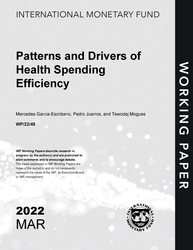
Patterns and Drivers of Health Spending Efficiency
Patterns and Drivers of Health Spending Efficiency
READ MORE...
Volume/Issue:
Volume 2022
Issue 048
Publication date: March 2022
ISBN: 9798400204838
$0.00
Add to Cart by clicking price of the language and format you'd like to purchase
Available Languages and Formats
| English |
Topics covered in this book
This title contains information about the following subjects.
Click on a subject if you would like to see other titles with the same subjects.
Economics- Macroeconomics , Public Finance , Economics / General , Health Policy , health sector , expenditure efficiency , universal health coverage , health outcome , health spending efficiency , health spending Efficiency , health intervention , health sector , health resource , Health care spending , Health care , Expenditure efficiency , Income , Global , Western Hemisphere
Summary
Demands for ramping up health expenditures are at an all-time high. Countries’ needs for additional health resources include responding to the COVID-19 pandemic, closing gaps in achieving the Sustainable Development Goal in health in most emerging and developing countries, and serving an ageing population in advanced economies. Facing limited fiscal space for raising health spending focuses policymakers’ attention on ensuring that resources are used efficiently. How sizable are the potential gains—in terms of freeing up resources and delivering better health outcomes—from improving health spending efficiency? How has efficiency evolved over the past decade? What can policymakers do to boost it? This paper estimates health spending efficiency across countries using bias-corrected data envelopment analysis and finds sizable differences in efficiency across countries, in particular among emerging and developing countries compared to advanced economies. The examination of the evolution of efficiency reveals that important efficiency gains have been made in the majority of countries. The paper also explores some of the key drivers of efficiency and finds that lower income inequality, less corruption, and health interventions oriented at expanding population access to basic health services are associated with greater efficiency.
Copyright © 2010 - 2025
Powered by:
AIDC



